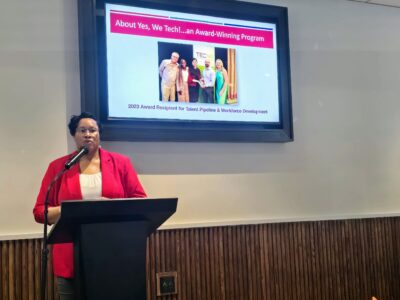Delaware has been gradually gaining recognition for its status as a haven for innovation and technology. Now more than ever, developing digitally-savvy students is of growing importance for the state.
For educators like Linden Hill Elementary fifth-grade math, science and social studies teacher Kristen Palma, implementing digital learning has become one of the most important ways to engage with the students at the school.
“Sometimes the quietest student in a classroom has the loudest voice in an online discussion,” Palma said. “These types of tools allow teachers and other students to share and show learning on a different level.”
Other Delaware teachers agree with Palma’s sentiment.
Colleen Hoban of Wilmington’s Tatnall School employs digital learning every day in her classroom. For her, technology isn’t just about having students play with drones. It’s about giving students options.
“Technology is just another tool for teachers, like a pen or piece of paper,” she said. “It can be easily integrated. It also gives students a choice – they can do it on paper, the board, tech – it gives them power.”
Hoban’s students have not only mastered intense technological projects like learning to code in second grade, but the young kids often surprise her with the innovative ways they want to incorporate digital learning into their own education.
“There are students who have asked to create their own website to start businesses,” Hoban said. “There are times when I think, ‘I never would’ve thought of that.’ They really do think outside the box.”
Turning elementary students into computer whizzes isn’t always an easy task, though.
For Linden Hill’s computer specialist Dr. Yanaka Bernal, the hardest part is the fact that her students don’t see her regularly.
“I have been the computer technology teacher at Linden Hill for 12 years,” Bernal said. “I think the hardest part of doing what I do is only seeing my students once a week. I would love to dive deeper into projects.”
The struggle in the traditional classroom is slightly different for Palma. For her, it’s difficult to decide between classic and digital teaching.
“We have a lot of great resources that we have been using for years and in addition, there are numerous digital resources that can allow me to really expand what I am teaching the students,” she said. “Finding the balance between the two is sometimes tricky.”
Technology is leaving its mark on classrooms across the state. Though incorporating digital learning in schools isn’t always easy nor affordable, Hoban, Bernal and Palma see it as a necessary advancement.
As with anything else, though, there’s room for improvement.
“The equity of tech needs to be improved in the state,” Hoban noted. “Not all students are exposed to tech due to budget, whether that’s because of lack of tools or not having the teachers to teach with the tools. But we’re moving in the right direction.”
Before you go...
Please consider supporting Technical.ly to keep our independent journalism strong. Unlike most business-focused media outlets, we don’t have a paywall. Instead, we count on your personal and organizational support.
3 ways to support our work:- Contribute to the Journalism Fund. Charitable giving ensures our information remains free and accessible for residents to discover workforce programs and entrepreneurship pathways. This includes philanthropic grants and individual tax-deductible donations from readers like you.
- Use our Preferred Partners. Our directory of vetted providers offers high-quality recommendations for services our readers need, and each referral supports our journalism.
- Use our services. If you need entrepreneurs and tech leaders to buy your services, are seeking technologists to hire or want more professionals to know about your ecosystem, Technical.ly has the biggest and most engaged audience in the mid-Atlantic. We help companies tell their stories and answer big questions to meet and serve our community.
Join our growing Slack community
Join 5,000 tech professionals and entrepreneurs in our community Slack today!





